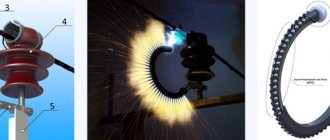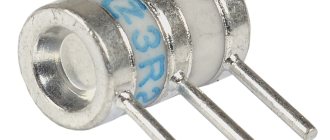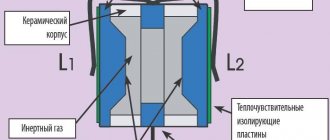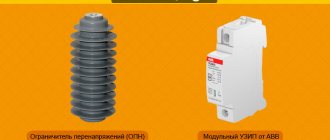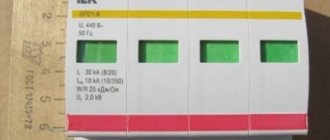For more information or to order products, please contact our managers.
RDIP-10 is a long-spark loop type arrester. The arrester is designed to protect overhead power lines (OHL) with a voltage of 6, 10 kV three-phase alternating current with bare and protected wires from induced lightning overvoltages.
The number of arresters successfully operated in many regions of Russia exceeds 1,000,000.
Beware, counterfeit! You can ask any questions regarding this topic by phone + 7 812 3270808 (ext. 159 or 139) or by mail.
Principle of operation
The operating principle of the arrester is based on the use of the sliding discharge effect, which provides a large length of pulse overlap along the surface of the arrester, and, due to this, as well as by dividing the discharge channel into parts by electrodes, preventing the transition of the pulse overlap into a power arc of industrial frequency current. When an induced overvoltage occurs on the overhead line wire, the spark gap between the clamp on the overhead line wire and the spark gap breaks through, and the voltage is applied to the insulation between the central tube of the loop and the insulation fittings having a support potential. Under the influence of an applied pulse voltage, a sliding discharge develops along the loop insulation surface from the central tube to the arrester mounting bracket (along one arm of the loop with electrodes). After the passage of the pulse current, the discharge goes out without turning into a power arc, which prevents the occurrence of a short circuit and shutdown of the overhead line.
Introduction to installing RDIP
Overhead line > Installation of long-spark arresters RDIP on VLZ-10 kV
INSTALLATION OF LONG-SPARK ARRANGEMENTS TYPE RDIP-10 ON SUPPORTS OF OHL 10 KV WITH PROTECTED WIRE. Code 23.0067
Explanatory note 23.0067-PZ
1. General part 1.1. The project for installing long-spark arresters of the RDIP-10 type on the supports of 10 kV overhead lines with protected wires was developed by ROSEP OJSC under agreement No. 415 dated September 26, 2003 with NPO Streamer OJSC. 1.2. During the operation of 6-10 kV overhead lines, shortcomings of arc protection devices of the SE20.1 and SE20.2 type from ENSTO (Finland) were identified. In particular, when passing an overhead line in a wooded area, when ice forms or snow sticks, tree branches can fall under the weight of ice (snow) and block areas of such devices that do not have an insulating coating and lead to disconnection of lines. In addition, repeated phase-to-phase short circuits when using devices of type SE 20.1 and SE 20.2 can lead to damage to substation equipment.1.3. In order to improve lightning protection of 6-10 kV overhead lines with protected wires, the scientific and technical council of RAO UES of Russia dated March 24, 2000 recognized the use of long-spark arresters (LDIS) as promising, based on the principle of lengthening the pulse overlap path to reduce the probability of pulse overlap transition into a power arc.1.4. The Department of Scientific and Technical Policy and International Cooperation and the Department of Electrical Networks of JSC FGC UES in the information letter IP-O2-2003(E) dated April 25, 2003, in order to increase the operational reliability of 6-10 kV overhead power lines, recommended installing long-spark gaps of the loop type ( RDIP).2. Directions for use 2.1. In this project, various fastening schemes have been developed on intermediate and anchor-angular supports of overhead lines for long-spark dischargers RDIP-10-4-UHL1 according to TU 3414-023-45533350-2002 in the following projects: - Single-circuit reinforced concrete supports with racks C112, SV110 and SV105 10 kV overhead line with protected wires Code L56-97.- Double-circuit reinforced concrete supports with racks C112, SV110 and SV164 10 kV overhead line with protected wires Code L57-97.- Reinforced concrete supports for joint suspension of protected wires of 10 kV overhead lines and self-supporting insulated wires of a single-circuit overhead line 0.4 kV. Code 19.0157.- Reinforced concrete supports for joint suspension of protected wires of a 10 kV overhead line and self-supporting insulated wires of two 0.4 kV circuit overhead lines. Code 20.0027.- Transitional reinforced concrete supports for 10 kV overhead lines with protected wires. Code 21.0050.2.2. For each support developed in the indicated projects (clause 2.1), instructions are given on the use of a specific type of fastening RDIP-10 (document 23.0067-05, etc.).2 3 On the supports of a single-circuit 10 kV overhead line, one RDIP-10 arrester is installed, on supports of a double-circuit overhead line 10 kV - two RDIP-10 arresters (document 23 0067-01); arresters are installed alternately on phases A, B, C, A, etc. 2.4. The list of products for all fastenings is given in document 23.0067-04.2.5. A general view and specifications for eight types of fastenings (P1...P8) are given in the drawings of this project.2.6. Working drawings of the traverses for fastenings P2 and P5 are given in documents 23.0067-20 and 23.0067-21.2.7. The scope of application of RDIP-10 arresters must comply with the requirements of TU 3414-023-45533350-2002.2.8. The issue of using RDIP-10 on a 10 kV overhead line in the joint-stock companies Krasnodarenergo, Stavropolenergo, Rostovenergo, Astrakhanenergo and Volgogradenergo is being resolved locally, taking into account the distribution of large birds (eagles, etc.) in the overhead line construction area.
Schemes for placing long-spark arresters RDIP-10 on single-circuit and double-circuit VLZ-10 kV 23.0067-01
Layout diagram of long-spark arresters RDIP-10 on a single-circuit 10 kV overhead line.
Layout of long-spark arresters RDIP-10 on a double-circuit overhead line 10 kV.
All pages of the section on WebsorIntroduction Installation of arrester RDIP-10 on a VLZ-10kV pole and their mounting diagrams Selection of types of fastening to supports for various projects Installation of arrester RDIP-10 on supports of various types Cross-arms for mounting arrester RDIP-10
Specifications
| Characteristic | RDIP-10 | |
| Voltage class, kV | 6, 10 | |
| Maximum continuous permissible operating voltage, kV | 12 | |
| Spark gap, mm | 20-40 | |
| Extinguishing the arc of a two-phase short-circuit current to ground with the effective value of the periodic component at the highest operating voltage of an overhead line up to 12 kV, kA | 0,6 | |
| Maximum amplitude of withstand pulse 8/20 µs, simulating a direct lightning strike, kA | 40 | |
| Pulse discharge voltage, kV | 120 | |
| One-minute alternating voltage, kV, not less: | ||
| - dry | 38 | |
| - under rain | 28 | |
| Length of overlap along the insulating surface, mm, not less | 360 | |
| Weight, kg | 2,4 | |
Comparison of RMK-20 and RDIP-10
The RMK multi-chamber spark gap contains all the positive properties of its predecessor - the RDIP long-spark gap.
RMK is applicable:
- for high-voltage lines with any types of supports: metal, reinforced concrete, wood;
- with any types of insulators: pin, tension, suspension, porcelain, glass, polymer;
- with any type of wires, both insulated and non-insulated;
The service life of the RMK is at least 30 years, the manufacturer’s warranty is 5 years.
In addition to the above advantages, RMK (compared to RDIP) has several more competitive advantages:
- The weight and dimensions of the RMK are significantly smaller than those of the RDIP, which simplifies its transportation and storage.
- Small dimensions and design facilitate easy installation, even under voltage, when using a special mounting bracket and a clamp on the wire (on a 6 kV overhead line with a bare wire - without a clamp).
- Possibility of operation on overhead lines 6 kV, 10 kV, 15 kV and 20 kV.
- Wind and ice loads have been significantly reduced.
- Has protection against birds landing on the product, i.e. eliminates the possibility of breaking the spark gap.
- Improved coordination with the isolator even when the air gap is broken.
- Attenuation of accompanying current up to 1.2 kA;
- Low cost.
Comparison table RDIP-10 and RMK-20
| Characteristics | RDIP-10 | RMK-20 |
| Pulse 50% discharge voltage, kV (the lower it is, the better the coordination of the arrester with the insulator, even if the air gap is violated) | 100 | 85 |
| Possibility of use on overhead lines 6-10-15-20 kV | 6-10 | 6-10-15-20 |
| Accompanying current that can extinguish the spark gap, A | 600-800 | 1200 |
| Withstand pulse current 8/50 μs, not less, kA | 20 | 20 |
| Possibility of use on overhead lines with SIP or bare wire, on all types of supports and insulation | Yes | Yes |
| Possibility of installation under voltage | No | Yes |
| Product weight, kg | 2,55 | 1,00 |
| Packaging volume (10 pcs. per box), cubic meters. | 0,16 | 0,02 |
| Compact, rigid design, least susceptible to air gap disruption during operation | No | Yes |
| Degree of pollution according to GOST 9920 | IV | IV |
| Damage to arrester elements when triggered | No | No |
| Warranty period, years | 5 | 5 |
| Service life, years | 30 | 30 |
| Availability of projects and recommendations of the Scientific and Technical Center of Electric Power Industry | Yes | Yes |
| Quality (Certificates and Declarations, Russia) | Yes | Yes |
| Quality control and testing of each product in production | Yes | Yes |
| Price | RMK is cheaper |
RMK-20 has passed all the necessary tests and is certified. Since the beginning of 2009, more than 100,000 RMK-20 products have been installed on overhead lines.
Installation
The arrester is installed on overhead lines with any types of supports and insulation.
On single-circuit overhead lines, to protect against induced overvoltages and their consequences, arresters are installed one on each support with regular sequential phase rotation. On double-circuit overhead lines, to protect against induced overvoltages and their consequences, 2 arresters are installed on each support, on one pair of phases of the same name, one arrester for each circuit, with the same principle of alternating protected phases as for single-circuit overhead lines.
At the same time, installing arresters on a support does not impose additional requirements on the presence of a grounding device and its resistance. The absence of additional requirements for grounding of supports is explained by the operating principle of RDIP-10 arresters. When a lightning overvoltage occurs, two arresters overlap on opposite phases, and an electrical circuit is formed that includes the grounding resistance of these two supports (Fig. 1). Thus, the presence of ground resistance on the supports helps limit the current passing through the arresters.
Figure 1 – Installation diagram of arresters on a single-circuit overhead line and illustration of their operation
Advantages
The arresters of the RDIM, RDIP, RMK series presented in the catalog make it possible to save the operating life of high-voltage circuit breakers. Devices that normalize voltage help prevent power line disconnection and wire burnout as a result of induced lightning overvoltage. The products provide protection of the electrical network from arc overvoltages.
The undoubted advantages of RMK, RDIP and RDIM arresters, which our company offers to buy at an affordable price, are their durability (at least 25 years of operation), wear resistance, and unpretentiousness (do not require maintenance). Lightning currents and accompanying arc fault currents do not flow through the design elements of the arrester, so the device is not subject to destructive influences.
Application
These arresters, which have the official abbreviated name RDIP-10-IV-UHL1 in accordance with the Technical Specifications approved in 2002, have passed all the necessary tests and certification, and have been accepted by MVK for serial production and mass operation in power systems.
Currently, RDIP-10-IV-UHL1 are increasingly used in various regions of the country during the construction of new, reconstruction and technical re-equipment of existing 6.10 kV overhead lines, in accordance with design solutions based on the necessary regulatory and technical documentation developed by the institute "JSC ROSEP" The number of arresters successfully operated in many regions of Russia exceeds 200,000.
RDIP-10 is designed to protect overhead power lines with a voltage of 6-10 kV three-phase alternating current with protected and bare wires from induced lightning overvoltages
and their consequences and is designed for outdoor operation at ambient temperatures from minus 60°C to plus 50°C for 30 years.
RDIP1-10-IV-UHL1
Long-spark loop arrester modified RDIP1-10-IV-UHL1
RDIP1-10 in terms of characteristics, principle of operation and purpose does not differ from the arrester RDIP-10-IV-UHL1, being only its structural modification.
The design difference between RDIP1 and RDIP comes down to the changed shape of the loop bend, the details of the fastening unit and the method of ensuring an air gap between the arrester and the wire. The air discharge gap between the RDIP1 electrode and the wire maintains the set parameters regardless of the geometry of the wire in the span and even when the wire slips in the harness on the insulator.
print version
